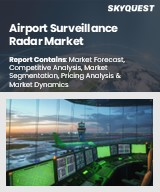
|
시장보고서
상품코드
1775599
공항 감시 레이더 시장 : 예측(2025-2030년)Airport Surveillance Radar Market - Forecasts from 2025 to 2030 |
||||||
공항 감시 레이더 시장은 CAGR 8.10%로, 2025년 70억 271만 6,000달러에서 2030년에는 103억 3,801만 달러로 성장할 것으로 예측됩니다.
공항 감시 레이더 시스템은 공항에서 사용되는 시스템으로 공항 주변의 항공우주 공간에서 항공기의 위치를 파악하고 표시하는 데 사용됩니다. 또한 공항 주변의 항공 교통을 모니터링하는 데에도 사용됩니다.
이 시스템은 항공 터미널에서 반경 30-50해리(56-93km) 이내의 교통량을 관리하고, 고도 25,000피트 미만의 항공기를 감지하고 추적할 수 있습니다. 여행 및 관광 산업의 성장에 따른 항공 교통량 증가는 승객의 안전에 대한 우려와 함께 이러한 레더에 대한 수요를 촉진할 것으로 예상되는 주요 요인 중 하나입니다. 감시체계의 미비로 인한 항공 업계의 사망사고가 증가함에 따라 전 세계 정부는 고도의 감시 기술을 갖추게 되었습니다. 또한, 많은 국가에서 안보 위협이 증가함에 따라 첨단 기술을 유지-강화하기 위한 국방 분야에 대한 투자가 증가하고 있으며, 이는 주요 리더 시스템 시장을 견인하는 요인이 될 것으로 예상됩니다. 그러나 현재 적절한 교육을 받은 인력이 부족합니다. 이는 미숙련된 인력에 의한 항공 서비스의 부적절한 관리로 인해 예측 기간 동안 시장 성장을 저해하는 위협이 될 수 있습니다. 그러나 구성요소와 시스템 모두에서 모니터링 기술의 지속적인 기술 발전과 세계 최신 기술의 채택은 예측 기간 동안 이 시장이 성장할 수 있는 기회가 될 것으로 예상됩니다.
공항 감시 레이더 세계 시장은 유형별로 1차 레이더와 2차 레이더로 구분됩니다. 1차 리더는 개발도상국 정부의 공항 확장 투자 증가로 인해 예측 기간 동안 큰 폭의 성장이 예상됩니다. 또한, 항공 교통량의 증가와 승객의 안전에 대한 관심이 높아짐에 따라 이러한 리더기 시장을 주도하고 있습니다. 그러나 2차 판독기도 1차 판독기와 함께 사용되기 때문에 높은 CAGR이 예상됩니다.
구성요소별로는 리더 유닛과 기타 통신 부품으로 구분됩니다. 레더 유닛은 내구성이 높고 수명이 길기 때문에 예측 기간 동안 큰 점유율을 차지할 것으로 예상됩니다. 또한, 신공항 건설에 대한 투자 증가와 최신 레이더 시스템 도입이 레이더 유닛의 수요를 예상할 수 있는 요인으로 작용하고 있습니다. 그러나 기타 통신부품 분야는 부품 교체 및 소프트웨어 업그레이드에 이어 다양한 신흥국에서 최신 기술 채택을 위한 부품 업그레이드가 이루어지고 있어 큰 폭의 성장이 예상됩니다.
지역별로는 북미, 남미, 유럽, 중동 및 아프리카, 아시아태평양 지역으로 구분됩니다. 아시아태평양은 전 세계 공항 모니터링 시장을 독점하고 있는데, 이는 중국, 인도 등의 국가에서 신공항 건설에 대한 민관 투자가 급증하고 있기 때문입니다. 이 지역의 여행 및 관광 산업의 성장은 가처분 소득의 증가와 함께 항공 여객 수송량을 증가시키고 있으며, 이는 이 지역의 공항 감시 레이더 시장 성장에 긍정적인 영향을 미치고 있습니다. 또한, 무역량의 증가는 화물 활동을 더욱 활발하게 하여 예측 기간 동안 아시아태평양의 공항 감시 레이더 시장의 성장에 기여하고 있습니다. 북미와 유럽은 항공여객 및 화물 운송량 증가에 대응하기 위한 기존 공항의 업그레이드에 대한 투자가 부족함에도 불구하고 신규 공항에 대한 투자가 부족하여 시장 성장률은 상당히 낮을 것으로 보입니다.
목차
제1장 주요 요약
제2장 시장 현황
- 시장 개요
- 시장 정의
- 조사 범위
- 시장 세분화
제3장 비즈니스 상황
- 시장 성장 촉진요인
- 시장 성장 억제요인
- 시장 기회
- Porter's Five Forces 분석
- 업계 밸류체인 분석
- 정책과 규제
- 전략적 제안
제4장 기술 전망
제5장 공항 감시 레이더 시장 : 유형별
- 소개
- 1차 레이더
- 2차 레이더
제6장 공항 감시 레이더 시장 : 기술별
- 소개
- 1차 감시 레이더(PSR)
- 2차 감시 레이더(SSR)
- 모드 S 레이더
- 다변측정(MLAT)
- 패시브 레이더
제7장 공항 감시 레이더 시장 : 구성요소별
- 소개
- 레이더 유닛
- 기타 통신 부품
제8장 공항 감시 레이더 시장 : 용도별
- 소개
- 항공교통관제(ATC)
- 방공
- 지상 이동 감시 레이더(SMR)
- 터미널 에어리어 감시
- 원격 타워 운영
제9장 공항 감시 레이더 시장 : 지역별
- 소개
- 북미
- 유형별
- 기술별
- 구성요소별
- 용도별
- 국가별
- 미국
- 캐나다
- 멕시코
- 남미
- 유형별
- 기술별
- 구성요소별
- 용도별
- 국가별
- 브라질
- 아르헨티나
- 기타
- 유럽
- 유형별
- 기술별
- 구성요소별
- 용도별
- 국가별
- 영국
- 독일
- 프랑스
- 스페인
- 기타
- 중동 및 아프리카
- 유형별
- 기술별
- 구성요소별
- 용도별
- 국가별
- 사우디아라비아
- 아랍에미리트
- 기타
- 아시아태평양
- 유형별
- 기술별
- 구성요소별
- 용도별
- 국가별
- 중국
- 일본
- 인도
- 한국
- 대만
- 기타
제10장 경쟁 환경과 분석
- 주요 기업과 전략 분석
- 시장 점유율 분석
- 합병, 인수, 합의 및 협업
- 경쟁 대시보드
제11장 기업 개요
- Lockheed Martin Corporation
- Raytheon Technologies Corporation
- Thales Group
- BAE Systems
- Northrop Grumman Corporation
- Leonardo S.p.A.
- L3Harris Technologies, Inc.
- Intelcan Technosystems Inc.
- Blighter Surveillance Systems Ltd.
- NEC Corporation
제12장 부록
- 통화
- 가정
- 기준 연도와 예측 연도 타임라인
- 이해관계자에 대한 주요 이점
- 조사 방법
- 약어
The airport surveillance radar market is expected to grow from US$7,002.716 million in 2025 to US$10,338.010 million in 2030, at a CAGR of 8.10%.
An airport surveillance radar system is a system that is used at airports to identify and exhibit the position of an airplane in aerospace around airports. It is used to monitor air traffic around the airport.
This system controls traffic inside a radius of 30 to 50 nautical miles (56 to 93 km) of the air terminal and can detect and track aircraft at altitudes less than 25,000 feet. The growing air traffic on account of growth in the travel and tourism industry, coupled with the growing safety concerns regarding passenger safety, is one of the prime factors expected to drive the demand for these radars. Growing fatalities in the aviation industry due to poor surveillance have led governments across the globe to equip advanced surveillance technology. Furthermore, growing investment in the defense sector to keep advanced technology is also expected to propel the market for primary radar systems on account of growing security threats in many countries. In addition, there is a lack of trained personnel at present. This may pose a threat to hindering the market growth during the forecast period due to improper management of air services by an unskilled workforce. However, the continuous technological advancements in surveillance technology in the case of both the components and the systems, coupled with the adoption of the latest technology worldwide, are expected to be an opportunity for this market to grow during the forecast period.
By type, the global airport surveillance radar market is segmented into primary radar and secondary radar. The primary radar segment is expected to witness substantial growth during the forecast period on account of increasing investments in the expansion of airports by the governments of developing countries. Furthermore, increasing air traffic and increasing safety concerns for passengers are also driving the market for these radars. However, the segment secondary radars are also expected to witness a high CAGR owing to their application along with the primary radar.
By component, the global airport surveillance radar market is segmented into radar units and other telecommunication components. The segment for radar units is expected to have a significant share during the forecast period on account of its durability and longevity. Furthermore, increasing investments in the construction of new airports and the adoption of the latest radar systems are the factors that are expected to anticipate the demand for radar units. However, the segment of other telecommunication components is expected to grow at a substantial rate because of the replacement of components, and software upgrades, followed by only the component up-gradation in various developing countries for the adoption of the latest technology.
By geography, the global airport surveillance radar market is segmented into North America, South America, Europe, the Middle East and Africa, and the Asia Pacific. APAC dominates the global airport surveillance market owing to the rapid rise in investments, both public and private, in the construction of new airports in countries like China and India. The growing travel and tourism industry in this region, coupled with rising disposable incomes, is boosting air passenger traffic, thus positively impacting the growth of the airport surveillance radar market in the region. Growing trade volume further boosts cargo activity, which also contributes to the growth of the APAC Airport Surveillance Radar market during the forecast period. North America and Europe will witness a considerably low market growth rate on account of the lack of investments in new airports, even though there has been a lack of investments in the up-gradation of existing airports to handle rising air passenger as well as cargo traffic.
Segmentation
The global airport surveillance radar market has been analyzed through the following segments:
By Type
- Primary Radar
- Secondary Radar
By Technology
- Primary Surveillance Radar (PSR)
- Secondary Surveillance Radar (SSR)
- Mode S Radar
- Multilateration (MLAT)
- Passive Radar
By Component
- Radar Unit
- Other Telecommunication Components
By Application
- Air Traffic Control (ATC)
- Air Defense
- Surface Movement Radar (SMR)
- Terminal Area Surveillance
- Remote Tower Operations
- By Geography
- North America
- Europe
- Asia Pacific
- South America
- Middle East & Africa
Companies Profiled
- Lockheed Martin Corporation
- Raytheon Technologies Corporation
- Thales Group
- BAE Systems
- Northrop Grumman Corporation
- Leonardo S.p.A.
- L3Harris Technologies, Inc.
- Intelcan Technosystems Inc.
- Blighter Surveillance Systems Ltd.
- NEC Corporation
TABLE OF CONTENTS
1. EXECUTIVE SUMMARY
2. MARKET SNAPSHOT
- 2.1. Market Overview
- 2.2. Market Definition
- 2.3. Scope of the Study
- 2.4. Market Segmentation
3. BUSINESS LANDSCAPE
- 3.1. Market Drivers
- 3.2. Market Restraints
- 3.3. Market Opportunities
- 3.4. Porter's Five Forces Analysis
- 3.5. Industry Value Chain Analysis
- 3.6. Policies and Regulations
- 3.7. Strategic Recommendations
4. TECHNOLOGICAL OUTLOOK
5. AIRPORT SURVEILLANCE RADAR MARKET BY TYPE
- 5.1. Introduction
- 5.2. Primary Radar
- 5.3. Secondary Radar
6. AIRPORT SURVEILLANCE RADAR MARKET BY TECHNOLOGY
- 6.1. Introduction
- 6.2. Primary Surveillance Radar (PSR)
- 6.3. Secondary Surveillance Radar (SSR)
- 6.4. Mode S Radar
- 6.5. Multilateration (MLAT)
- 6.6. Passive Radar
7. AIRPORT SURVEILLANCE RADAR MARKET BY COMPONENT
- 7.1. Introduction
- 7.2. Radar Unit
- 7.3. Other Telecommunication Components
8. AIRPORT SURVEILLANCE RADAR MARKET BY APPLICATION
- 8.1. Introduction
- 8.2. Air Traffic Control (ATC)
- 8.3. Air Defense
- 8.4. Surface Movement Radar (SMR)
- 8.5. Terminal Area Surveillance
- 8.6. Remote Tower Operations
9. AIRPORT SURVEILLANCE RADAR MARKET BY GEOGRAPHY
- 9.1. Introduction
- 9.2. North America
- 9.2.1. By Type
- 9.2.2. By Technology
- 9.2.3. By Component
- 9.2.4. By Application
- 9.2.5. By Country
- 9.2.5.1. USA
- 9.2.5.2. Canada
- 9.2.5.3. Mexico
- 9.3. South America
- 9.3.1. By Type
- 9.3.2. By Technology
- 9.3.3. By Component
- 9.3.4. By Application
- 9.3.5. By Country
- 9.3.5.1. Brazil
- 9.3.5.2. Argentina
- 9.3.5.3. Others
- 9.4. Europe
- 9.4.1. By Type
- 9.4.2. By Technology
- 9.4.3. By Component
- 9.4.4. By Application
- 9.4.5. By Country
- 9.4.5.1. United Kingdom
- 9.4.5.2. Germany
- 9.4.5.3. France
- 9.4.5.4. Spain
- 9.4.5.5. Others
- 9.5. Middle East and Africa
- 9.5.1. By Type
- 9.5.2. By Technology
- 9.5.3. By Component
- 9.5.4. By Application
- 9.5.5. By Country
- 9.5.5.1. Saudi Arabia
- 9.5.5.2. UAE
- 9.5.5.3. Others
- 9.6. Asia Pacific
- 9.6.1. By Type
- 9.6.2. By Technology
- 9.6.3. By Component
- 9.6.4. By Application
- 9.6.5. By Country
- 9.6.5.1. China
- 9.6.5.2. Japan
- 9.6.5.3. India
- 9.6.5.4. South Korea
- 9.6.5.5. Taiwan
- 9.6.5.6. Others
10. COMPETITIVE ENVIRONMENT AND ANALYSIS
- 10.1. Major Players and Strategy Analysis
- 10.2. Market Share Analysis
- 10.3. Mergers, Acquisitions, Agreements, and Collaborations
- 10.4. Competitive Dashboard
11. COMPANY PROFILES
- 11.1. Lockheed Martin Corporation
- 11.2. Raytheon Technologies Corporation
- 11.3. Thales Group
- 11.4. BAE Systems
- 11.5. Northrop Grumman Corporation
- 11.6. Leonardo S.p.A.
- 11.7. L3Harris Technologies, Inc.
- 11.8. Intelcan Technosystems Inc.
- 11.9. Blighter Surveillance Systems Ltd.
- 11.10. NEC Corporation
12. APPENDIX
- 12.1. Currency
- 12.2. Assumptions
- 12.3. Base and Forecast Years Timeline
- 12.4. Key Benefits for the Stakeholders
- 12.5. Research Methodology
- 12.6. Abbreviations


















